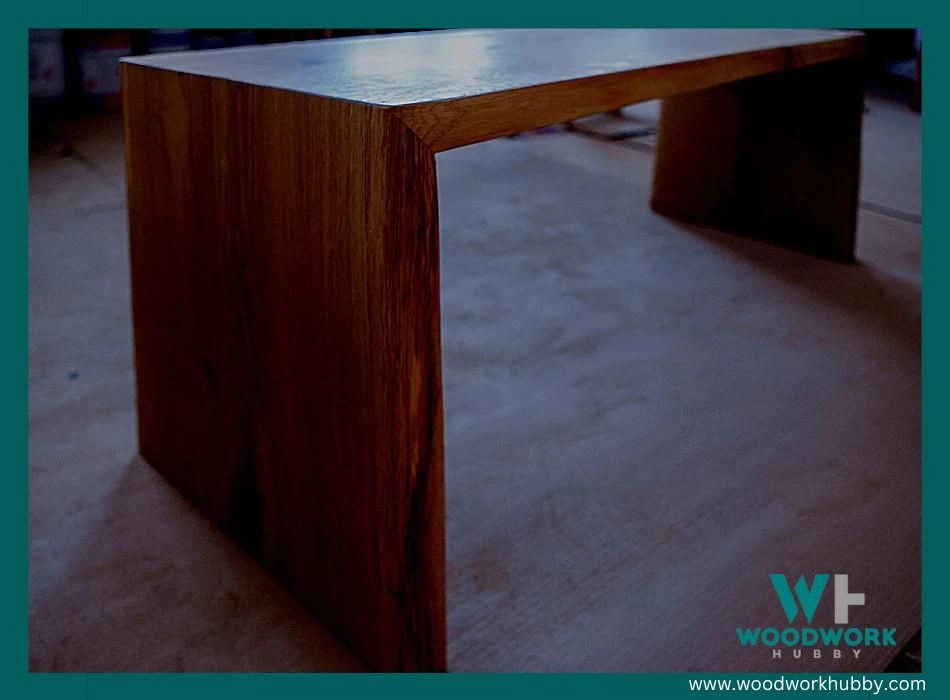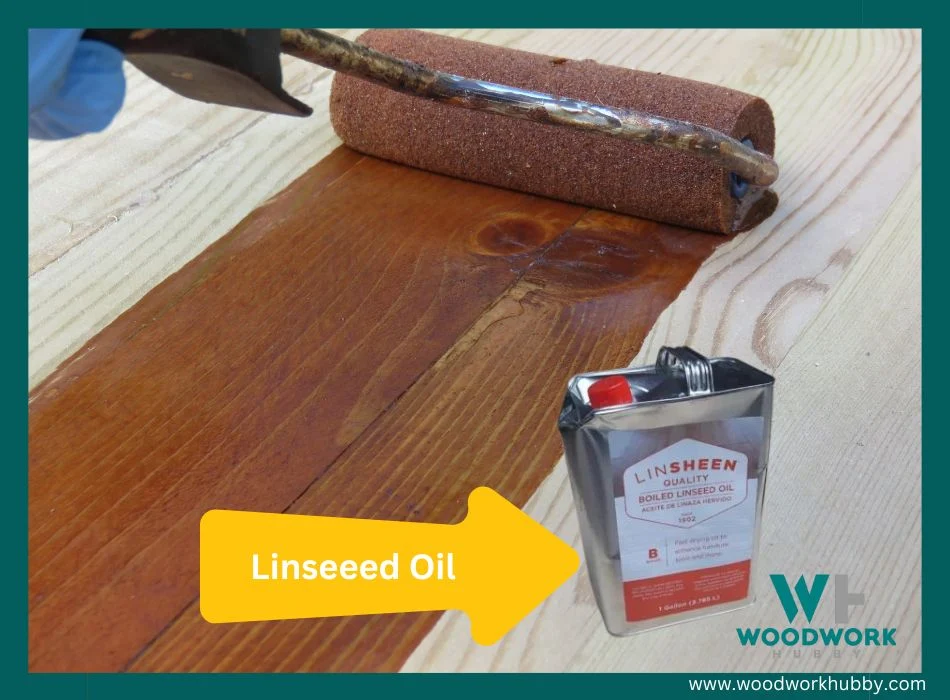Woodworking seems like cutting and sawing to the layperson. But a true woodworker knows that the most important step that decides the visual appeal of a project is the finish applied to the project lumber. Linseed oil is one of my favorite oil treatments. Whenever I recommend it to new woodworkers, I get asked if linseed oil will darken the wood.
Linseed oil will darken the wood and change its hue to a slightly warmer-looking appearance. This works best on wood that is naturally dark. Lighter wood starts looking too yellow, which doesn’t always look good. Darker wood looks richer with a linseed oil coat.
In this article, you will discover everything I learned, having used linseed oil on over 80 times of wood across 20 years of woodworking. Among the things you’ll learn are the best practices of using linseed oil over wood, the types of wood that adhere the best to linseed oil, and alternative finishes that can darken wood better.
Does Linseed Oil Change Wood Color?

Linseed oil changes the color of wood if the wood is not inherently dark. Because linseed oil has a golden tint and it yellows over time, the temperature of lighter wood is visibly raised once it is coated with linseed oil.
The video shows the oil finish comparison using boiled linseed oil, tung oil, clou hartol, danish oil, and tru oil.
Before you take that to mean anything for your finish selection, please consider a few things. Even the finish with the most opaque color will affect only some types of lumber.
Think about it this way: red paint doesn’t change the color of red wood because it is already red. So, whenever a finish is not visually neutral, you must ask yourself which types of wood its tint will not be visible in.
Linseed oil has a golden tint means you can use it on lumber that is too dark for a golden tint. importantly, it means that you should not use it on light wood where the golden tint will appear yellow.
Here is what I have learned about linseed oil’s lumber compatibility in my 20 years of woodworking:
| Wood Type | Should I use linseed oil on it? |
|---|---|
| White Oak | Linseed oil will add a yellow tint to the oak lumber, making it look cheap. |
| Teak | Linseed oil will enrich teak by bringing out the natural golden hue masked by its deep red and brown hues. |
| White Pine | White pine looks okay after being coated with linseed oil. However, it starts looking sickly yellow after three to four months. |
| Red Oak | The deep red versions of Red Oak can persevere against the yellowish tint of linseed oil. But most Red Oak panels look artificial when coated with linseed oil. |
| Maple | Maple is naturally light, which means it is not an ideal wood type to be coated in a color-carrying finish. |
| Western White Pine | Western white pine is too light to be coated with linseed oil |
| White Ash | White Ash may be coated with linseed oil since its aesthetic value is rarely its prime selling point. But if a white ash project is meant to be decorative in nature, you should use a neutral-looking finish. |
| Mahogany | Coating mahogany in any type of finish can be risky because of the lumber price. However, Linseed oil works well on mahogany and makes it look richer. |
| Beechwood | Beechwood looks like plywood if it is coated in linseed oil. It takes a while for the yellowing to take effect. But when its color temperature is raised, beechwood doesn’t look good. |
| Rosewood | Rosewood looks better with linseed oil. The lighter hues from its red color pop with a lift from the yellow of the linseed oil. |
| Ebony Wood | Ebony wood is dark to the point where linseed oil doesn’t affect its color. If you use linseed oil over it, you should do so based on properties aside from its color. |
How Long Does Linseed Oil Take To Darken?
Linseed oil starts darkening 24 hours after its application and can continue darkening for up to 10 weeks.
If you’re not satisfied with how dark the finish is, try placing the project in total darkness. Doing this might accelerate the darkening process.
You might make the mistake that I used to make early on. When you coat the wood in linseed oil and find it dry to touch, you assume it has achieved its maximum possible darkness. That’s not the case, but you might apply yet another coat to get the oil to darken. This would only lead to yet another cycle.
Darkness is Essential
I discovered that while other finishes required light to set, linseed oil would darken in the absence of light. The more time the wood spends in the absence of light, the more linseed oil will cure a darker appearance.
The yellowness that comes with darkening usually is due to sunlight exposure.
I let my linseed oil treatment set in a shed where light isn’t as abundant as in my main workshop. But if you can’t have a separate place to let your project wood rest, you can use a black tablecloth.

Before I had a separate shed for this, I used to cover wood with a dark tablecloth when it was dry to the touch. You can use the Sancta Table cover for this as it is sufficiently opaque and versatile in that you can use it for other purposes when you are not using it to cure linseed oil in the dark.
You Have Time Until It Cures
If you’ve read the above while your oil-coated lumber has been sitting in the open, don’t fret. You can still move it to a dark location to promote a darker tint.
The general rule of thumb with linseed oil is that you have time until the oil cures. Once the linseed oil has fully cured, it can only yellow. This makes the actual type of linseed oil you use very important.
- Boiled linseed oil cures faster than raw linseed oil. This means it darkens faster but also that it stops darkening earlier than raw linseed oil. And while raw linseed oil takes weeks to darken, you have more time to place it in a dark place.
- Boiled linseed oil darkens in 24 to 72 hours, provided that it is allowed to cure in complete darkness.
- Raw linseed oil, when cured in complete darkness, takes 2 to 10 weeks. In the case of raw linseed oil, you can start off drying in an open-air environment and then place it in the dark later.
What To Do if Linseed Oil Isn’t Dark Enough
In case you have given the above a shot and find that linseed oil is just not darkening the wood enough, you might want to change the oil content. When I am okay with staining wood to darken it, I add a dark oil-based tint to the linseed oil.
This allows me to control the level of darkness without going to an extreme color-changing outcome. You can follow suit if you want to. Just avoid using water-based tints because oil and water do not mix.
What Oil Will Darken Wood?
It is generally a good idea not to tunnel-vision on a single finish, stain, or wax when you can consider multiple options and find a better one. If the end goal of your finishing treatment is darkness, then linseed oil is an option but is not the only option.
Danish Oil, Linseed Oil, and Hard Wax oil will all darken the wood, albeit at different color temperatures. While linseed oil has a yellower tint, danish oil and hard wax oil produce a deeper finish.
Redder wood benefits from danish oil, while dark wood is best served by a coat of linseed oil.
The video shows how to apply danish oil to wood
Darkness and Color Temperature: A Primer
At this point, discussing darkness and color temperature is very important. Because we often associate darkness with the color black. And black is inherently a cold-tined color. However, when I say that linseed oil will darken the wood, I do not mean it will make the wood black.
It will just reduce the light reflection from the wood surface so that it appears to have a deeper color. Depth of color, or lack of lightness, is not equivalent to being black.
Yellow is considered a warm color, and blue is considered a cool one. And when you raise the color temperature of wood, you don’t make the wood hot. You make the color of the wood yellower.
Linseed oil’s effect is that it makes wood yellow but also less bright. Black and dark wood types appear darker, while lighter wood types appear dim.
Does Linseed Oil Stain Wood?
The discussion of yellow and blue might make you wonder if linseed oil has a staining property or if it can actually be used to stain wood.
Linseed oil does not stain the wood, but it does accommodate oil-based stains. That means you can mix an oil-based stain with linseed oil or buy a pre-mixed linseed oil-based stain. In either case, the applied product will not penetrate as deep into the wood.
Option 1: Linseed Oil and Oil Stain Mix
If you mix linseed oil and oil stain, you have more freedom but also the likelihood of more mistakes. There are no rules to mixing oil finish with stain, and you might not know how a specific finish might reflect on wood.

If you use linseed oil with an oil-stain mix, how well the two combine also depends on the oil itself. If the oil is pre-saturated with tint, then linseed oil might not mix very well. When making the stain mix yourself, you have to accept that you will need to learn through trial and error.
Option 2: Linseed-oil-Based-stain
The next option you have is to get a pre-mixed linseed oil stain. The advantage of this purchase is simply that the finish is somewhat predictable. You can look at customer reviews of such products since they always come with pictures. Another benefit of getting a pre-mixed stain is that you don’t have to spend a lot of time mixing and testing it yourself.
The drawback of getting such a mix is that it doesn’t penetrate into the wood. One of the greatest strengths of linseed oil is that it seeps into the wood right down to the actual grain and makes it pop. But when you use a linseed oil stain, the mixture is too thick to run past the surface.
To understand this better, check out my post on whether stain penetrates the wood. Pay attention to the viscosity factor because the mix isn’t really viscous enough for deep penetration. But if that’s not what you want to begin with, then a linseed oil-based stain is the best thing for you.
Option 3: Use Linseed Oil and Follow It Up With Wood Stain
The final option offsets the drawbacks of both the first and the second options.
- When you use linseed oil to saturate the wood surface, you ensure that the oil seeps into the wood and strengths it at depth. This offsets the problem with the linseed oil-based wax, which doesn’t penetrate as deeply.
- The second thing is that it allows you to familiarize yourself with one color. Once you know the final color of the wood with just the linseed oil, you can proceed to stain only if it is necessary. You can also decide the stain concentration based on this.

However, there are drawbacks to this option as well. Nothing is entirely drawback-free in woodworking anyway.
The disadvantage of using linseed oil and then a wood stain is that you have to wait a long time. With boiled linseed oil, you have to wait 3 days before you can stain the project. And with raw linseed oil, you have to wait up to 10 weeks.
Darkening wood and staining it are two different things, and of course, it is best for the results to take things one step at a time. But if you have urgent orders, you cannot afford to set and forget linseed oil while you wait for the project to be stain-ready.
Final Thoughts -Will Linseed Oil Darken Wood?
Linseed oil darkens wood but also gives it a yellowish tint. The yellowness is most obvious in lighter types of wood.
These types of wood should be coated with Danish oil or hard wax oil instead. Linseed oil works best on deep and reddish wood types as it brings out the best in them.




